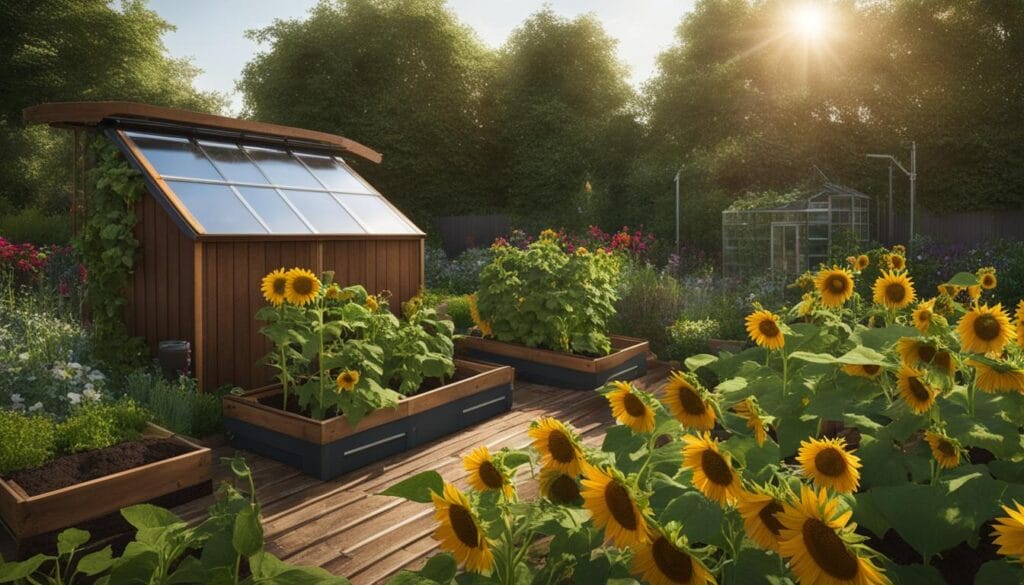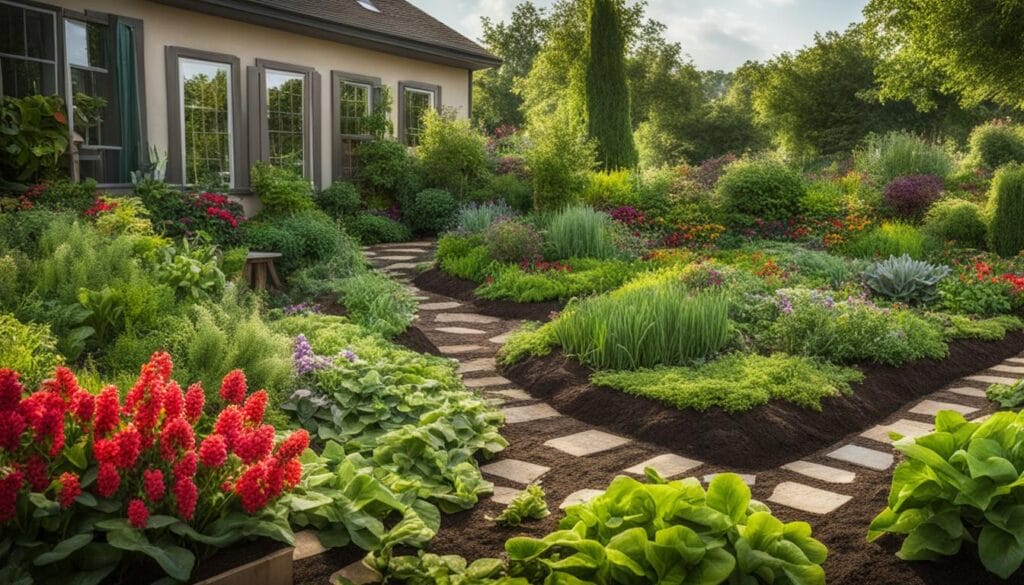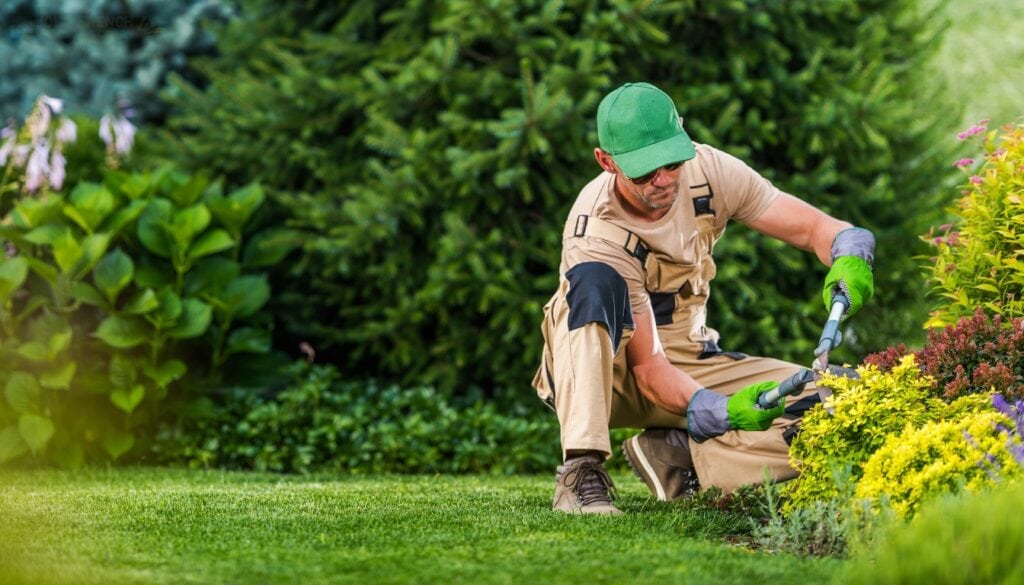In order to create a flourishing garden, it is essential to prioritize the health and sustainability of your soil. Sustainable soil management and eco-friendly landscaping practices play a vital role in maintaining a thriving ecosystem in your garden. By adopting these practices, you can conserve moisture, prevent erosion, and ensure the long-term viability of your plants.
- Sustainable soil management is crucial for a healthy garden ecosystem.
- Eco-friendly landscaping practices can conserve moisture and prevent erosion.
- The health of your soil directly impacts the vitality of your plants.
- By enhancing soil sustainability, you contribute to a more sustainable environment.
- Implementing organic gardening techniques promotes soil health and longevity.
The Benefits of Sustainable Garden Soil
Sustainable garden soil offers numerous benefits for plants, the environment, and gardeners. By practicing organic gardening techniques and implementing regenerative agriculture methods, you can improve soil conservation and create a more sustainable urban soil management system. Here are some key advantages of sustainable garden soil:
- Prevents Compaction: Sustainable garden soil is rich in organic matter, which helps improve its structure and prevent compaction. This allows plant roots to penetrate the soil more easily, resulting in healthier and more productive plants.
- Provides Essential Nutrients: Healthy soil contains a balanced mix of nutrients that plants need to thrive. When sustainable soil management practices are followed, organic matter and natural fertilizers are added to the soil, ensuring a steady supply of nutrients for plant growth.
- Conserves Moisture: Sustainable garden soil has improved water-holding capacity, reducing the need for frequent watering. This not only saves water but also helps plants withstand drought conditions.
- Encourages Beneficial Organisms: By avoiding the use of synthetic pesticides and chemical fertilizers, sustainable garden soil promotes the growth of beneficial organisms such as earthworms and beneficial bacteria. These organisms help break down organic matter, release nutrients, and improve soil health.
In summary, sustainable garden soil is essential for organic gardening, regenerative agriculture, and soil conservation. It provides a fertile and supportive environment for plant growth, while also minimizing harm to the environment and promoting the well-being of gardeners. By adopting sustainable urban soil management practices, you can create a thriving garden ecosystem that is both environmentally friendly and productive.

Improving Soil Health in Your Garden
Enhancing the health of your garden’s soil is essential for creating a thriving outdoor space. By implementing a few simple practices, you can improve soil quality, prevent erosion, and promote sustainable landscaping. Let’s explore some practical tips for enhancing soil health in your garden.
Mulching to Boost Organic Matter
Adding organic matter to your soil is a key step in improving its structure and fertility. One effective way to do this is through mulching. Mulch acts as a protective layer, retaining moisture and preventing soil erosion. Additionally, as the mulch breaks down, it adds organic matter to the soil, enhancing its nutrient content.
There are various types of mulch you can use, such as compost, wood chips, straw, or leaves. Apply a layer of mulch around your plants, ensuring it is about 2-3 inches thick. Make sure to keep the mulch a few inches away from the stems or trunks of the plants to prevent rot.
Cover Cropping for Soil Conservation
Another effective method for improving soil health is cover cropping. Cover crops, such as legumes or grasses, are planted between main crop seasons or in areas where plants are not actively growing. These crops help prevent soil erosion by protecting the soil from wind and water erosion.
Additionally, cover crops add organic matter to the soil when they are tilled or incorporated into the ground. They also improve soil structure, increase nutrient availability, and enhance water infiltration. Some popular cover crops include clover, vetch, rye, and buckwheat. Choose cover crops that are suitable for your climate and gardening goals.
Implementing Sustainable Landscaping Solutions
To further enhance soil health and prevent erosion, consider implementing sustainable landscaping solutions. Rain barrels and rain gardens are excellent options for minimizing water runoff and protecting the soil from erosion. Rain barrels collect rainwater from your roof, which can then be used to water your plants, reducing the need for additional irrigation.
On the other hand, rain gardens are designed to capture and absorb rainwater, preventing it from flowing off your property. They can be strategically placed in areas where runoff is common, such as near downspouts or sloped areas. By directing and retaining rainwater, rain gardens help replenish the soil’s moisture and prevent erosion.
| Sustainable Landscaping Solutions | Benefits |
|---|---|
| Rain Barrels | – Reduce water runoff |
| -Conserve water resources | |
| Rain Gardens | – Prevent soil erosion |
| – Replenish soil moisture |
By implementing these practices and incorporating sustainable landscaping solutions, you can significantly improve the health and sustainability of your garden’s soil. Remember to choose organic mulches, suitable cover crops, and properly position rain barrels and rain gardens to maximize their benefits. With these simple steps, your garden will thrive while minimizing environmental impact.

Embracing Sustainable Gardening Practices
Sustainable gardening is an eco-friendly approach to landscaping that prioritizes the use of organic solutions and promotes environmentally friendly practices. By implementing these practices, you not only create a healthier and more vibrant garden, but also contribute to the overall well-being of the planet.
One of the key aspects of sustainable gardening is avoiding the use of chemical fertilizers and pesticides. Instead, opt for organic alternatives that are safer for the environment and help maintain the natural balance of your garden. These alternatives include natural pest control methods such as companion planting, which involves growing certain plants together to deter pests, and using biological controls like ladybugs or nematodes.
Another important practice in sustainable gardening is preserving natural resources. By conserving water and reducing waste, you can minimize your environmental impact. Implementing proper watering techniques, such as using drip irrigation or installing a rainwater harvesting system, can significantly reduce water consumption in your garden. Additionally, reusing and recycling materials for garden projects can help minimize waste and promote a more sustainable approach.
Benefits of Sustainable Gardening
Embracing sustainable gardening practices comes with a wide range of benefits. Not only does it promote a healthier garden ecosystem, but it also helps to create a more resilient and sustainable landscape. By focusing on organic solutions and eco-friendly landscaping, you can:
- Protect the health of your family and pets by avoiding exposure to harmful chemicals
- Promote biodiversity and attract beneficial insects, birds, and wildlife to your garden
- Reduce water consumption and minimize the impact of drought conditions
- Conserve resources and reduce waste by practicing recycling and reusing in your garden projects
- Create a beautiful and environmentally friendly outdoor space that you can enjoy for years to come
By embracing sustainable gardening practices, you can take an active role in protecting the environment and creating a more eco-friendly garden. From using organic solutions to conserving water and resources, every small step you take can make a big difference in preserving the beauty and sustainability of your garden.
Green Landscaping for a Sustainable Yard
Creating a sustainable yard is not only beneficial for the environment but also adds beauty and functionality to your outdoor space. By incorporating green landscaping practices, you can reduce your ecological footprint and create a more sustainable landscape design. Here are some key elements to consider:
Native Plants
One of the foundations of green landscaping is the use of native plants. These are plants that naturally occur in your region and are well-adapted to the local climate and soil conditions. Native plants require less water, fertilizer, and maintenance compared to exotic species. They also provide essential habitat and food for local wildlife, contributing to a more biodiverse ecosystem.
Hardscaping
Integrating hardscaping features into your yard design can enhance sustainability. Utilizing permeable pavers or gravel pathways allows rainwater to infiltrate the soil instead of becoming runoff. This helps replenish groundwater and reduces the strain on stormwater systems. Additionally, incorporating raised beds or retaining walls made from recycled materials adds visual interest while reducing waste.
| Green Landscaping Benefits | Sustainable Landscape Design |
|---|---|
| Conserves water | Native plants reduce the need for excessive watering. |
| Reduces pollution | Permeable pavers minimize water runoff and filter pollutants. |
| Enhances biodiversity | Native plants provide habitat for insects, birds, and other wildlife. |
| Minimizes maintenance | Choosing low-maintenance plants reduces the need for pruning and mowing. |
Green landscaping not only benefits the environment but also creates a welcoming and sustainable outdoor space for you and your family. By incorporating native plants, hardscaping features, and other eco-friendly practices, you can transform your yard into a haven for both nature and relaxation.
Remember, sustainability is an ongoing process, and small changes can make a big difference. By adopting green landscaping practices, you can contribute to a healthier ecosystem while enjoying a beautiful and sustainable yard.
Xeriscaping: Conserving Water in Your Garden
When it comes to sustainable garden practices, water conservation plays a vital role. With increasing concerns about water scarcity in many areas, adopting water-saving techniques in your garden is not only environmentally responsible but also cost-effective. Xeriscaping, rainwater harvesting, and drought-tolerant landscaping are effective strategies that can help reduce water consumption while maintaining a beautiful and thriving garden.
What is Xeriscaping?
Xeriscaping is a landscaping method that focuses on using drought-tolerant plants and minimizing water usage. By selecting native or adapted plants that are well-suited to your region’s climate, you can create a water-efficient garden that requires minimal irrigation. The key principles of xeriscaping include proper planning, soil improvement, efficient irrigation, mulching, and regular maintenance. By incorporating these practices, you can significantly reduce your water usage while still enjoying a vibrant and visually appealing garden.
The Benefits of Rainwater Harvesting
Rainwater harvesting is an excellent way to conserve water and reduce reliance on traditional water sources for irrigation. By collecting rainwater from roofs, gutters, and other surfaces, you can store and use this free and abundant resource in your garden. Installing a rain barrel or a larger rainwater harvesting system allows you to capture and store rainwater for dry periods, significantly reducing the need for municipal water or well water. Rainwater is naturally devoid of chemicals and is beneficial for plants, making it an ideal choice for watering your garden.
Drought-Tolerant Landscaping
Another effective way to conserve water in your garden is through drought-tolerant landscaping. By selecting plants that have evolved to thrive in arid conditions, you can minimize water requirements and still have a beautiful garden. Drought-tolerant plants are typically adapted to low rainfall, have deep root systems, and can withstand periods of drought without significant stress. Incorporating hardscaping features such as gravel paths or rock gardens can also reduce water needs and add visual interest to your outdoor space.
| Plant Name | Water Requirement | Sunlight Requirement |
|---|---|---|
| Lavender | Low | Full sun |
| Agave | Low | Full sun |
| Yucca | Low | Full sun to partial shade |
| Sedum | Low to moderate | Full sun to partial shade |
As shown in the table above, there are several drought-tolerant plants available that require minimal water and thrive in various sunlight conditions. By incorporating these plants into your garden, you can create a sustainable and water-efficient landscape.
Conclusion
By prioritizing sustainable garden practices and embracing environmentally friendly landscaping, you can create a thriving and eco-conscious outdoor space. Through organic gardening techniques and water conservation, you can contribute to the health and sustainability of your garden as well as the surrounding environment.
Remember, small changes in your gardening routine can make a significant impact. By choosing sustainable methods such as using organic solutions for pest control, avoiding chemical fertilizers and pesticides, and preserving natural resources, you can create a more environmentally friendly garden.
Additionally, incorporating green landscaping with native plants, wildlife habitats, and hardscaping features like permeable pavers can further minimize water consumption, reduce pollution, and save energy. These practices not only benefit your garden but also contribute to a more sustainable future.
FAQ
What is soil sustainability in landscaping?
Soil sustainability in landscaping refers to the practices employed to build and maintain healthy soil in your garden while minimizing harm to the environment. It involves methods like organic gardening, soil conservation, and sustainable urban soil management.
Why is soil health important for my garden?
Soil health is crucial for the growth and vitality of your garden. Healthy soil provides essential nutrients, prevents compaction, conserves moisture, and supports the growth of beneficial organisms. By prioritizing soil health, you can create a more resilient and thriving garden ecosystem.
How can I improve soil health in my garden?
You can enhance soil health by adding organic matter like compost to improve soil structure and fertility. Using cover crops, mulching, and well-rotted manure can also increase organic matter and prevent soil erosion. Implementing sustainable landscaping solutions like rain barrels and rain gardens can help conserve water and protect the soil.
What are the benefits of sustainable garden soil?
Sustainable garden soil offers numerous benefits. It helps prevent compaction, provides essential nutrients to plants, conserves moisture, and encourages the growth of beneficial organisms. By practicing sustainable soil management, you can create a more resilient garden ecosystem.
What is sustainable gardening?
Sustainable gardening involves practices that minimize harm to the environment and promote the well-being of your garden. It includes using organic solutions for pest control, avoiding chemical fertilizers and pesticides, and preserving natural resources. Choosing native plants, proper watering techniques, and maintaining a compost system are also part of sustainable gardening.
What is green landscaping?
Green landscaping is an eco-friendly approach to yard design and maintenance. It aims to conserve resources and reduce waste by using native plants, creating wildlife habitats, and incorporating hardscaping features like permeable pavers. Green landscaping helps reduce water consumption, minimize pollution, and save energy.
How can I conserve water in my garden?
You can conserve water by practicing xeriscaping, which focuses on drought-tolerant plants and efficient water use. Collecting rainwater through rain barrels and rain gardens is another effective way to conserve water in the garden. These practices are especially important in areas with water scarcity.
How can I create an eco-friendly garden?
To create an eco-friendly garden, prioritize soil health, embrace sustainable gardening practices, and implement green landscaping solutions. By using organic gardening techniques, conserving water, and practicing sustainable garden practices, you can create an environmentally friendly and sustainable garden.



